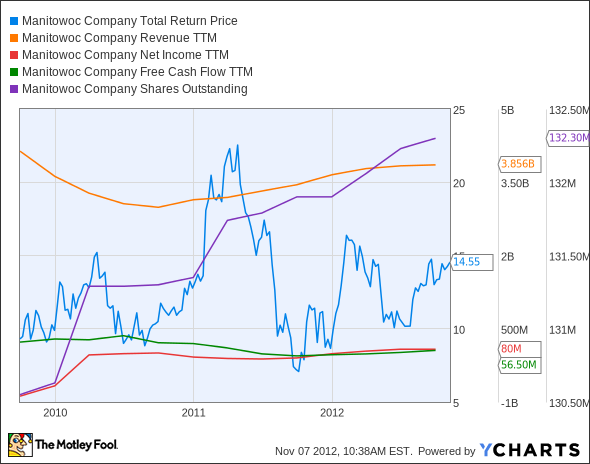Every investor can appreciate a stock that consistently beats the Street without getting ahead of its fundamentals and risking a meltdown. The best stocks offer sustainable market-beating gains, with improving financial metrics that support strong price growth. Let's look at what Manitowoc's (MTW 2.54%) recent results tell us about its potential for future gains.
What the numbers tell you
The graphs you're about to see tell Manitowoc's story, and we'll be grading the quality of that story in several ways.
Growth is important on both top and bottom lines, and an improving profit margin is a great sign that a company's become more efficient over time. Since profits may not always reported at a steady rate, we'll also look at how much Manitowoc's free cash flow has grown in comparison to its net income.
A company that generates more earnings per share over time, regardless of the number of shares outstanding, is heading in the right direction. If Manitowoc's share price has kept pace with its earnings growth, that's another good sign that its stock can move higher.
Is Manitowoc managing its resources well? A company's return on equity should be improving, and its debt to equity ratio declining, if it's to earn our approval.
By the numbers
Now, let's take a look at Manitowoc's key statistics:
MTW Total Return Price data by YCharts
|
Passing Criteria |
3-Year* Change |
Grade |
|---|---|---|
|
Revenue Growth > 30% |
(6.8%) |
Fail |
|
Improving Profit Margin |
262.2% |
Pass |
|
Free Cash Flow Growth > Net Income Growth |
(75.1%) vs. 109.1% |
Fail |
|
Improving Earnings per Share |
109.1% |
Pass |
|
Stock Growth (+ 15%) < EPS Growth |
56.4% vs. 109.1% |
Pass |
Source: YCharts. *Period begins at end of Q3 2009.
MTW Return on Equity data by YCharts
|
Passing Criteria |
3-Year* Change |
Grade |
|---|---|---|
|
Improving Return on Equity |
116.9% |
Pass |
|
Declining Debt to Equity |
(4.5%) |
Pass |
|
Dividend Growth > 25% |
300% |
Pass |
|
Free Cash Flow Payout Ratio < 50% |
0% |
Pass |
Source: YCharts. *Period begins at end of Q3 2009.
How we got here and where we're going
Manitowoc earns an impressive seven out of nine possible passing grades. However, two of those -- its dividend growth and its free cash flow payout ratio -- are based on somewhat outdated information, as Manitowoc pays out on an annual basis, and will pay out the same $0.08-per-share dividend as last year at the end of November. At that point, both its dividend growth rate and payout ratio may change, but neither seems likely to fall below passing. Do these seven passing grades make Manitowoc a buy today? Let's dig a little deeper.
As a major industrial-equipment maker, Manitowoc is every bit as vulnerable to macroeconomic shocks as larger bellwether Caterpillar (CAT 0.75%), which has served as a block against further gains since offering a disappointing long-term forecast just over a month ago. On the other hand, Caterpillar and Terex (TEX 2.01%) are more internationally diversified than Manitowoc, which could easily work in Manitowoc's favor in 2013. The global economy may be slowing, but the United States has been one of the few bright spots, and historically low construction spending looks to be turning up again. Manitowoc has a way to go to capitalize on this opportunity -- its most recent earnings report showed a company still struggling to regain its footing.
Manitowoc also has two weights around it that are larger than those holding back Caterpillar and Terex, as well as Joy Global (JOY +0.00%) and farm-focused Deere (DE +0.28%). Fool analyst Rex Moore points out that Manitowoc's P/E is higher than its peers, and despite a decline in its debt-to-equity ratio, Manitowoc still carries a large debt load. Its latest quarterly report pushed Manitowoc's P/E to 21.9, making it the most highly valued stock in the heavy-equipment sector. Terex, at second place with an 18.4 P/E, has a debt-to-equity ratio that's less than a third as large as Manitowoc's, a lower amount of long-term debt, and more than four times the annual free cash flow. Of these companies, only Deere has a higher debt-to-equity ratio than Manitowoc.
To counter these problems and grow its bottom line, Manitowoc's building rugged cranes in Brazil, a perfect location for growth thanks to that country's hosting of the 2014 World Cup and 2016 Olympics. Manitowoc's lesser-followed business segment, its food-service equipment, has earned plaudits from global fast-food leader McDonald's (MCD 0.69%) and could become a major growth driver in the coming years. There's ample room for expansion in the food-service industry, which has lower capital demands than commercial construction. Who knows? In a few years, we might be talking about Manitowoc as a food-service supplier that builds cranes on the side.
Putting the pieces together
Today, Manitowoc has some of the qualities that make up a great stock, but no stock is truly perfect. Digging deeper can help you uncover the answers you need to make a great buy -- or to stay away from a stock that's going nowhere.











